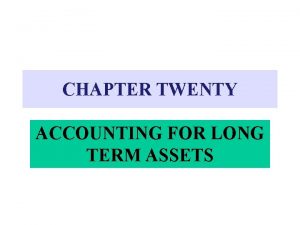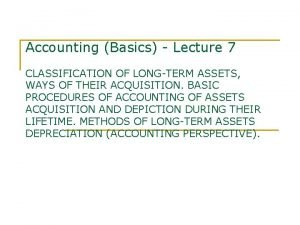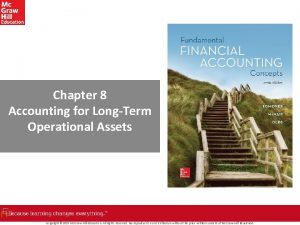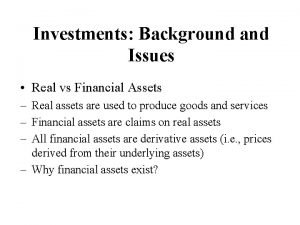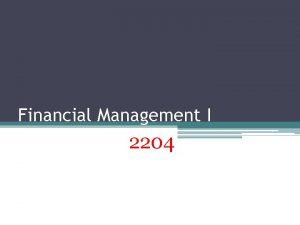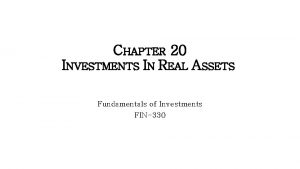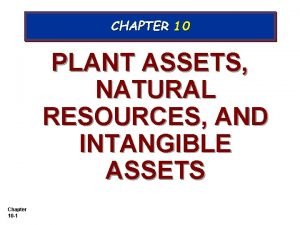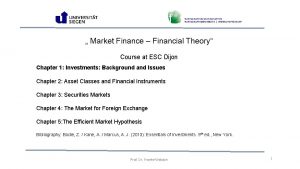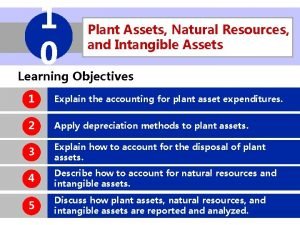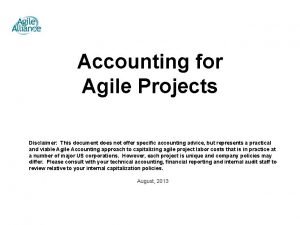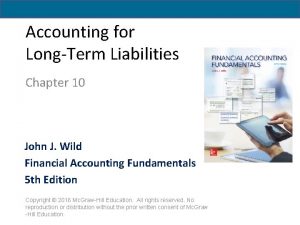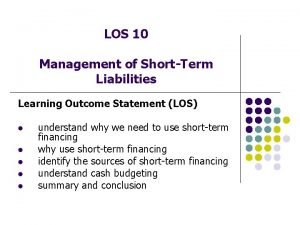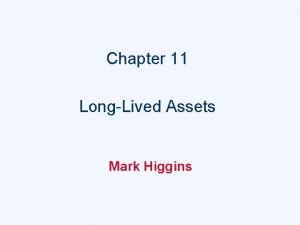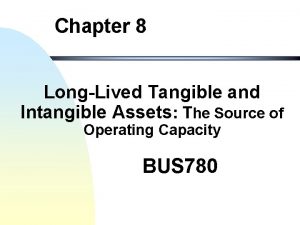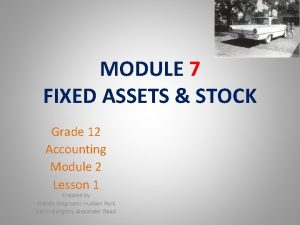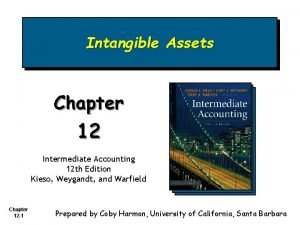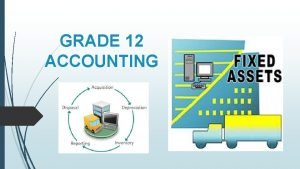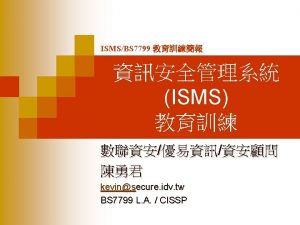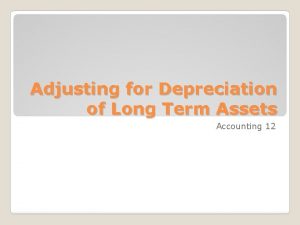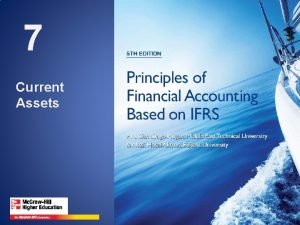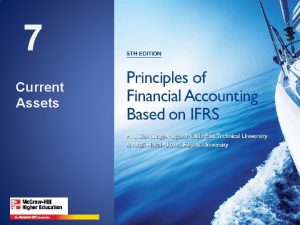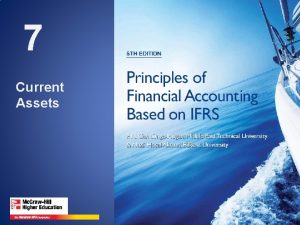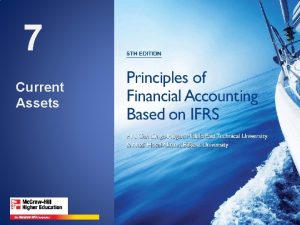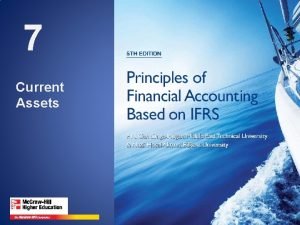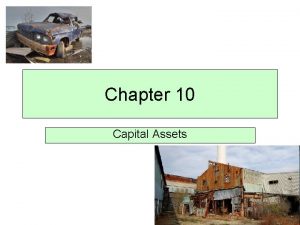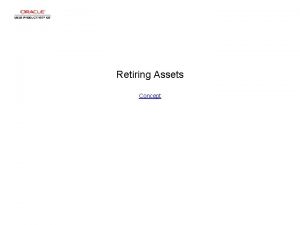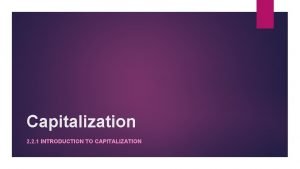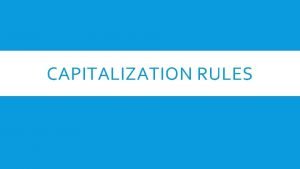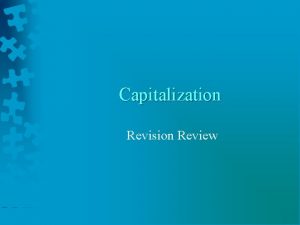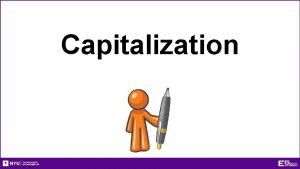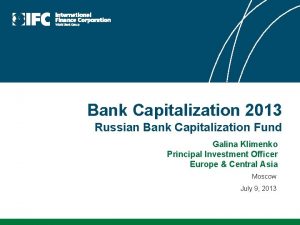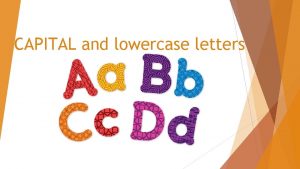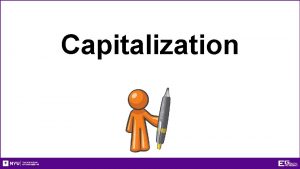Software Capitalization Training 2017 Long Term Assets Accounting
































- Slides: 32

Software Capitalization Training 2017 Long Term Assets – Accounting Last Updated January 2017

Welcome to Software Capitalization Training! Associate Education is a key control in the Software Capitalization Accounting process. As an internal and external audit measure, each CAP Y project manager is required to complete the Software Capitalization Web-Based Training course once a year. In addition, all new cap y project owners must complete the course prior to project ownership. Project Managers must score 85% or higher on the final assessment to satisfy the audit requirement. We greatly appreciate your compliance! The Software Capitalization Training will cover the following topics: • • • External & Internal Software Capitalization Technical Feasibility The Importance of Amortization Tracking Software Capitalization Creating a Capitalized Project Number Capitalized Third-Party Consultants Responsibilities of Project Owners and Associates Timesheet Approvals Internal & External Audits Conclusion Reference Pages Assessment

The Basics

External Software Capitalization - The Basics What is External Software Capitalization? • Assets resulting from salaries and other direct expenses incurred in software development • Software that is made generally available to clients What activities can be capitalized? • Creation or enhancement of software code after technological feasibility (technical design document or working model) has been established • Creation of code that broadly affects saleable solution What activities cannot be capitalized? • Support, break-fix or defect correction work post release/General Availability • Development of code for a single client (customization) • For further guidance, please email SWCAP@cerner. com How does Software Capitalization benefit Cerner? • Capitalized assets are amortized (expensed) over five years, spreading out the cost of development to match with the anticipated revenue • Software Capitalization offsets personnel expense © Cerner Corporation. All rights reserved. This document contains Cerner confidential and/or proprietary information belonging to Cerner Corporation and/or its related affiliates which may not be reproduced or transmitted in any form or by any means without the express written consent of Cerner. 3

Internal Software Capitalization - The Basics What is Internal Software Capitalization? • Assets resulting from salaries and other direct expenses incurred in software development for internal use • Software that is made available to Associates What are the requirements to capitalize internal software development? • Software is internally developed or modified to meet the entity’s internal needs AND • During development, no plan exists to market the software externally When can we begin capitalization? • When the preliminary project stage is complete. Preliminary project stage generally includes the following activities: • Conceptual formulation of alternatives • Evaluation of alternatives • Determination of needed technology • Final selection of alternatives • When management authorizes and commits to funding • When it is probable that the project will be completed and used for the function intended. 4 © Cerner Corporation. All rights reserved. This document contains Cerner confidential and/or proprietary information belonging to Cerner Corporation and/or its related affiliates which may not be reproduced or transmitted in any form or by any means without the express written consent of Cerner.

Amortization What is Amortization? • Amortization is the process of expensing the capitalized amount (asset) over 5 years, referred to as "deferring" the expense to future periods. What is the purpose of Amortization? • The purpose of amortization is to match the timing of when we recognize the expenses we incur for developing the software to the same period that we receive the revenue for the software/solution. When do we start Amortization for EXTERNAL Projects? • Amortization must start when the project is “released” or made generally available (GA) to our clients. • The SWCAP Accountant must confirm with the Project Manager whether the GA release did occur and what the exact date was. When do we start Amortization for INTERNAL Projects? • Amortization must start when the software is substantially complete and ready for its intended use (after testing is completed). • The SWCAP Accountant must confirm with the Project Manager whether the release did occur and what the exact date was. 5 © Cerner Corporation. All rights reserved. This document contains Cerner confidential and/or proprietary information belonging to Cerner Corporation and/or its related affiliates which may not be reproduced or transmitted in any form or by any means without the express written consent of Cerner.

Technical Feasibility

Technical Feasibility • In order to begin capitalizing software development, the project must first meet technical feasibility per Generally Accepted Accounting Principles (GAAP). A technical design document (or evidence of a working model) is required prior to the creation of a CAP Y project number AND for every subsequent software enhancement. • Please Note: Cap P ("Pending") Time is not capitalized. Detail Program Design/Technical Design Document Requirements: • Date in which the document was in place • Project Number/Project Description • Business Justification • Detailed Program/Technical Design • For additional guidance and template, refer here: Guidelines & Template Wiki Page Working Model Requirements/Details: • • Date in which it was made available for testing Sufficient evidence that the model was made available for testing An existing platform does not qualify as a "working model" A "working model" should be a replica of the intended design and ready for initial testing 7 © Cerner Corporation. All rights reserved. This document contains Cerner confidential and/or proprietary information belonging to Cerner Corporation and/or its related affiliates which may not be reproduced or transmitted in any form or by any means without the express written consent of Cerner.

Basis for Technical Feasibility Requirements KPMG, Background and Industry Trends: "Critical Definitions" states the following: "Technological Feasibility is established when the enterprise has completed all planning, designing, coding, and testing activities that are necessary to establish that the product can be produced to meet its design specifications including functions, features, and technical performance requirements. At a minimum, the enterprise shall have performed the activities in either (A) or (B) below as evidence that the technological feasibility has been established. A) If the process of creating the computer software product includes a detail program design: 1. The product design and the detail program design have been completed, and the enterprise has established that the necessary skills, hardware, and software technology are available to the enterprise to produce the product. 2. The completeness of the detail program design and its consistency with the product design have been confirmed by documenting and tracing the detail program design to the product specifications. 3. The detail program design has been reviewed for high-risk development issues (for example, novel, unique, unproven functions and features of technological innovations), and any uncertainties related to identified high-risk development issues have been resolved through coding and testing. B) If the process of creating the computer software product does not include a detail program design with the features identified in (A) above: 1. A product design and working model of the software product have been completed. 2. The completeness of the working model and its consistency with the product design have been confirmed by testing. Working Model: An operative version of the software product that is completed in the same software language as the product to be ultimately marketed, performs all the major functions planned for the product, and is ready for initial customer testing (usually identified as beta testing). Detail Program Design: A detail design of computer software product that takes product function, feature, and technical requirements to their most detailed, logical form and is ready for coding [emphasis added]. " © Cerner Corporation. All rights reserved. This document contains Cerner confidential and/or proprietary information belonging to Cerner Corporation and/or its related affiliates which may not be reproduced or transmitted in any form or by any means without the express written consent of Cerner. 8

Technical Feasibility for Enhancements FAS ASC 985 -20 -55 -21 states the following: "Product enhancements are specifically included in the scope of this Subtopic and, as such, are subject to the same requirements as any other software product. However, technological feasibility may be more easily established for a product enhancement than for a new product, and capitalization of costs may, therefore, begin relatively earlier in the software process. For example, an enhancement that adds one function to an already successful product may require only minor modifications to the original product's detail program design to establish technological feasibility [emphasis added]. " 9 © Cerner Corporation. All rights reserved. This document contains Cerner confidential and/or proprietary information belonging to Cerner Corporation and/or its related affiliates which may not be reproduced or transmitted in any form or by any means without the express written consent of Cerner.

Tracking Software Capitalization

Tracking Software Capitalization During the Month: • Associates fill out timesheet and expense reports in People. Soft and log to the appropriate CAP Y project numbers. • The time and expense reports are reviewed by the Project Managers in People. Soft to verify that the time/expense is logged correctly. Month-End Accounting: • The SWCAP Accountants capitalize (creates assets for) the salaries associated with the hours logged to the CAP Y project numbers each month-end close. • The cost of all CAP Y salaries and expenses are put on Cerner's Balance Sheet as non-amortizing assets until the associated projects go Generally Available (or ready for intended use, if Internal Software). • Each month, the SWCAP Accountants begin to amortize any Software Cap assets that had a GA release in that month. In order to accurately do so, the SWCAP Accountants require confirmation of the release with an exact date from the Project Owner. • Once a project releases, the associated asset amortizes over 5 years. 11 © Cerner Corporation. All rights reserved. This document contains Cerner confidential and/or proprietary information belonging to Cerner Corporation and/or its related affiliates which may not be reproduced or transmitted in any form or by any means without the express written consent of Cerner.

To Request a Software Cap Project Code Capitalized project codes are requested through the Project Code Request Form (here). Click below to access the tool, information regarding the fields, field guidelines, and the email address for questions. Upon submission of the request, a JIRA issue will be automatically logged. The project manager & project code owner will receive an email once it is assigned. Note: Google Chrome is the suggested browser for the tooling. Request Tool Info on Fields LINKS Form Guideline s Questions 12 © Cerner Corporation. All rights reserved. This document contains Cerner confidential and/or proprietary information belonging to Cerner Corporation and/or its related affiliates which may not be reproduced or transmitted in any form or by any means without the express written consent of Cerner.

Required Information to Create a CAP Y Project Code Name • 30 -character name for the project Project Code Owner • Associate responsible for owning the project code and for approving time associated with the project GA Release Date • The first anticipated date that a project will be made Generally Available – this is just an estimate used for tracking and is required for all projects. For internal projects, please provide the date when the software project will be ready for intended use. Internal or External Development • Will the software development/enhancement be used by Cerner Associates (Internal) OR made generally available to clients (External)? Enterprise & Major Initiative (External SW) • Used by both Finance and the ESO-Investment Management groups for reporting. • Should align with enterprise portfolio dashboard and Corporate Imperatives Category • Categorization to determine the appropriate classification of the project code. The categories are: Administration, Certification, Incremental Small Enhancements, Internal Project, Regression, Support, & Tracked with ESO. Completed Technical Feasibility Documents • A technical design document is required and must be submitted for all Cap Y projects. Project Managers must provide a link to the technical design document(s) upon project number request. • If there is no technical design document, the project will be set up as Cap Pending until the document is approved. Capitalization Questions • (Y/N) Is work logged under project time code development or enhancement work (not support, maintenance, or break-fix)? • (Y/N) Will software development/enhancement broadly impact saleable code (not customized for a single client)? 13 © Cerner Corporation. All rights reserved. This document contains Cerner confidential and/or proprietary information belonging to Cerner Corporation and/or its related affiliates which may not be reproduced or transmitted in any form or by any means without the express written consent of Cerner.

To Request All Other Project Codes Log a Ticket via My. Cerner (ASK) • Area: CMO – Project Number Management; • Sub Area: Internal PN Request 14 © Cerner Corporation. All rights reserved. This document contains Cerner confidential and/or proprietary information belonging to Cerner Corporation and/or its related affiliates which may not be reproduced or transmitted in any form or by any means without the express written consent of Cerner.

Requesting Project Code Changes/Closures The Project Code Request Form (here) should also be used to request the following: Project Changes & Project Closures. Upon submission of the request, a JIRA issue will be automatically logged. The project manager will receive an email once it is assigned. Project Changes Project Closures Cap P to Cap Y changes Close project codes Project Owner changes Estimated GA Date changes Provide final GA date 15 © Cerner Corporation. All rights reserved. This document contains Cerner confidential and/or proprietary information belonging to Cerner Corporation and/or its related affiliates which may not be reproduced or transmitted in any form or by any means without the express written consent of Cerner.

Capitalized Third-Party Consultants Accounting Guidelines • Cerner can capitalize amounts paid to third-parties for co-development of software • Cerner must own the rights to the Intellectual Property being developed Capitalized Consulting Process • Begin by contacting the ESO-Investment Management team for all contingent workforce requests. • Capitalized consultants must be approved through e. Procurement or the VMS Beeline system. Have Questions? • Feel free to reach out to the Software Cap Accountants (SWCAP@cerner. com) or ESO-investment management (IPPMOCerner@Cerner. com). • This saves a lot of time on the front-end to ensure the requisition and purchase order are created correctly • Also be sure to discuss third-party consulting plans with your Finance Plan team or Controller when creating expense budgets © Cerner Corporation. All rights reserved. This document contains Cerner confidential and/or proprietary information belonging to Cerner Corporation and/or its related affiliates which may not be reproduced or transmitted in any form or by any means without the express written consent of Cerner. 16

Project Best Practices ü All projects are to be created for a specific intended project release ü A single project code should be working towards a single GA release date at a given point in time. ü Multiple phases of a project should be logged against separate project codes to distinguish which cost corresponds to each phase. ü Accounting cannot partially release a project code ü A CAP N project number should accompany every CAP Y project for afterü ü ü release work and administrative work. If a development project includes support, break-fix or defect correction work, time must be logged against a CAP N project number. All sporadic projects should be closed after GA release All monthly projects should be closed after 1 year lifespan Estimated GA release dates provided upon initial project code creation and throughout the life of the project, are imperative to accurate forecasting and appropriate accounting, please ensure they are accurate. All correspondence regarding new project code requests, change requests, and closure requests should be through the auto-logged JIRA issue. 17 © Cerner Corporation. All rights reserved. This document contains Cerner confidential and/or proprietary information belonging to Cerner Corporation and/or its related affiliates which may not be reproduced or transmitted in any form or by any means without the express written consent of Cerner.

Key Responsibilities

Key Responsibilities of Project Managers • It is imperative that project managers continually monitor CAP Y project activity so that the amount of capitalization is accurate. • To ensure this takes place, here are key responsibilities for Project Managers. Inform the Software Capitalization team of any changes in capitalization status AND GA release dates/schedules as soon as possible Reply in a timely manner to communication from the SWCAP Accountants confirming if the CAP Y project has been made generally available and the exact date. Manually approve timesheets every Monday by 8: 00 PM (CST) Participate in the Quarterly Project Audit conducted during the third month of every quarter Participate in any external audit project questionnaire or tech feasibility requests Complete required Web Based Trainings 19 © Cerner Corporation. All rights reserved. This document contains Cerner confidential and/or proprietary information belonging to Cerner Corporation and/or its related affiliates which may not be reproduced or transmitted in any form or by any means without the express written consent of Cerner.

Key Responsibilities of Associates & Contractors • It is imperative that Associates & third-party consultants are informed about how to appropriately use CAP Y project codes. • As the project manager, it is your responsibility to discuss these responsibilities to the individuals logging to your project codes. Diligently log your time to the appropriate project number and activity code each week Discuss with your manager, project owner or SWCAP Accountants if you are unsure of which project number to use Submit your timesheet on time (Saturday 11: 59 PM (CST) is the weekly deadline) 20 © Cerner Corporation. All rights reserved. This document contains Cerner confidential and/or proprietary information belonging to Cerner Corporation and/or its related affiliates which may not be reproduced or transmitted in any form or by any means without the express written consent of Cerner.

Timesheet Approvals • Timesheets are an integral component in the capitalization process. To ensure we are capitalizing correctly, and for the correct amounts, project managers are required to manually approve CAP Y timesheets. The audit requirement is 85% manual approvals. • If a timesheet is not manually approved, it will be picked up in the auto approval cycle. All timesheets not manually approved and submitted prior to Saturday 11: 59 PM (CST), are auto approved by People. Soft Monday at 8: 00 PM (CST). Timesheets submitted after the Saturday deadline will be auto-approved the following Monday, if not manually approved prior. • Project Managers who do not maintain 85% manual approvals will receive an auto -generated email every two weeks throughout the quarter until 85% manual approvals is achieved. For information regarding specific auto-generated emails, contact the individuals listed on the Timesheet Approval Summary email. How To’s: • How to Manually Approve a Timesheet • How to Proxy Timesheet Approvals 21 © Cerner Corporation. All rights reserved. This document contains Cerner confidential and/or proprietary information belonging to Cerner Corporation and/or its related affiliates which may not be reproduced or transmitted in any form or by any means without the express written consent of Cerner.

Quarterly Project Audit • Once a quarter, as an audit measure, Finance requires all CAP Y Project Managers to review all of the CAP Y project numbers they own to ensure we are properly accounting for them. • As we capitalize the time and expense for the project, we depend on information from project managers to accurately capitalize and amortize (expense) the amounts in the correct periods. • This has a material impact on our financial statements as well as provides critical information for our Quarterly close process. • The Quarterly Project Audit is housed as a web form. Each third month of every quarter (March, June, September & December), the audit begins with an email from the Finance - Long Term Assets team. 22 © Cerner Corporation. All rights reserved. This document contains Cerner confidential and/or proprietary information belonging to Cerner Corporation and/or its related affiliates which may not be reproduced or transmitted in any form or by any means without the express written consent of Cerner.

Quarterly Project Audit During the project number review, please pay special attention to: Cap Status • This gives us the opportunity to catch capitalization mistakes before they escalate GA Dates (Date of General Availability) • GA Date field is required for all release schedules • “Last GA Date” should be the most recent release, or blank if the project has not met GA • “Next GA Date” should be an estimate of the next date the project will meet GA Cap Pending Projects • Is this project truly still Cap Pending? • Provide the date in which the project met technical feasibility OR an estimate of when technical feasibility will be reached • If technical feasibility has been achieved, please be prepared to provide technical feasibility document upon request. Should the project be close? • If the project has met GA, it should be closed immediately. • Closing projects in a timely manner helps avoid the incorrect logging of time to a Cap Y project • Closed projects are often included in the quarterly project audit to ensure that the recorded "final" GA date is still accurate 23 © Cerner Corporation. All rights reserved. This document contains Cerner confidential and/or proprietary information belonging to Cerner Corporation and/or its related affiliates which may not be reproduced or transmitted in any form or by any means without the express written consent of Cerner.

Additional Required Audits Technical Feasibility Audit General Availability Audit • Project codes are selected randomly for proof that the development project has met technological feasibility. • A technical design document (including business justification & technical design) dated on or before the start of capitalization of the project must be provided. • Each piece of documentation should be dated and easily traced back to the project number being audited. • Project codes are selected randomly for proof that the development was made generally available. • Generally, a notice to clients, release announcement, or proof that the code was made available on the Cerner store is provided which must be dated the same day the project started amortization. • Each piece of documentation should be dated and easily traced back to the project number being audited. 24 © Cerner Corporation. All rights reserved. This document contains Cerner confidential and/or proprietary information belonging to Cerner Corporation and/or its related affiliates which may not be reproduced or transmitted in any form or by any means without the express written consent of Cerner.

Additional Required Audits Software Capitalization Questionnaire • Project codes are selected randomly and sent to project owners asking for: • The solution related to the project code • A detailed description of the project for work in the current year • If the project became capitalizable during the current year • The date of technological feasibility • Internal or External Software • A description of how the project owner is reviewing associate timesheets (must be able to prove that you are manually approving at least 85% of all timesheets) 25 © Cerner Corporation. All rights reserved. This document contains Cerner confidential and/or proprietary information belonging to Cerner Corporation and/or its related affiliates which may not be reproduced or transmitted in any form or by any means without the express written consent of Cerner.

Additional Required Audits S. U. R. P. Audit & Questionnaire • S. U. R. P. = Search for un-released projects • Un-released project codes are selected randomly and sent to project owners asking for: • The solution related to the project code • A detailed description of the project code • Internal or External Software • Date of technological feasibility • Technical Feasibility document • Estimated GA release date • A description of how the project owner is reviewing associate timesheets (must be able to prove that you are manually approving at least 85% of all timesheets) © Cerner Corporation. All rights reserved. This document contains Cerner confidential and/or proprietary information belonging to Cerner Corporation and/or its related affiliates which may not be reproduced or transmitted in any form or by any means without the express written consent of Cerner. 26

Additional Information

Software Capitalization Statistics • Over the past couple of years, Software Capitalization has grown tremendously, both by number of CAP Y projects and capitalization. 28 © Cerner Corporation. All rights reserved. This document contains Cerner confidential and/or proprietary information belonging to Cerner Corporation and/or its related affiliates which may not be reproduced or transmitted in any form or by any means without the express written consent of Cerner.

Software Capitalization Abbreviations GA Tech Feas or “TF” SWCAP • Generally Available (External) / Ready for Intended Use (Internal) • Technically Feasible • Software Capitalization PN • Project Number PM • Project Manager who approves time/expense CAP Y • Capitalization-Yes CAP P • Capitalization-Pending CAP N • Capitalization-No QPA • Quarterly Project Audit LTA • Long Term Assets / Accounting Team PMO • Program Management Office SW • Software PO • Purchase Order REQ • e. Procurement Requisition © Cerner Corporation. All rights reserved. This document contains Cerner confidential and/or proprietary information belonging to Cerner Corporation and/or its related affiliates which may not be reproduced or transmitted in any form or by any means without the express written consent of Cerner. 29

Contact Information for Additional Questions • SWCAP@cerner. com (Mailbox for Software Capitalization Accounting Team) • IPPMO-Cerner@cerner. com (Mailbox for ESO-Investment Management Team) Accounting Contacts • Aigne’ Gould, Software Capitalization Accountant • 816. 906. 0233 • Aigne. Gould@cerner. com • Jen Maynard, Software Capitalization Accountant • 816. 201. 6151 • Jen. Maynard@cerner. com • Brittany Folken, Sr Software Capitalization Accountant • 816. 201. 7285 • Brittany. Folken@cerner. com • Kendra Lee, Long Term Assets Sr Team Lead • 816. 201. 3472 • Kendra. Lee@cerner. com Contact us if you: • Have questions regarding whether work can be capitalized • Have questions regarding this training course • Have questions regarding your specific project

Reference Pages – Links • Project Code Form: • • • https: //wiki. ucern. com/display/public/PMOCon. Doc/Technical+Feasibility+Template https: //wiki. ucern. com/display/public/PMOCon. Doc/IP+Capitalization+Management+FAQ https: //wiki. ucern. com/display/public/PMOCon. Doc/IP+Capitalization+Management+Guideline How To: • • • https: //wiki. ucern. com/display/public/PMOCon. Doc/Technical+Feasibility+Guideline IP Capitalization Management: • • • https: //wiki. ucern. com/display/public/PMOCon. Doc/New+Initiative+Request+and+Project+Code+Form+Guideline Technical Feasibility: • • • https: //wiki. ucern. com/display/public/PMOCon. Doc/New+Initiative+and+Project+Code+Form https: //wiki. ucern. com/display/associates/Approving Time Entry and Prior Period Adjustments https: //my. cerner. com/org/Finance/Long Term Assets/SWCap/Training/How to Set up a Proxy Approver. docx Email Contact: • • swcap@cerner. com IPPMO-cerner@cerner. com 31 © Cerner Corporation. All rights reserved. This document contains Cerner confidential and/or proprietary information belonging to Cerner Corporation and/or its related affiliates which may not be reproduced or transmitted in any form or by any means without the express written consent of Cerner.
 Franchise amortization
Franchise amortization Sum of the years method of depreciation
Sum of the years method of depreciation Other long term assets
Other long term assets The equipment
The equipment Long term operational assets
Long term operational assets Financial assets vs real assets
Financial assets vs real assets Real assets vs financial assets
Real assets vs financial assets Real assets vs financial assets
Real assets vs financial assets Plant assets natural resources and intangible assets
Plant assets natural resources and intangible assets Accumulated depreciation straight line method
Accumulated depreciation straight line method Lanni products is a start up computer
Lanni products is a start up computer Plant assets, natural resources, and intangible assets
Plant assets, natural resources, and intangible assets Agile software development capitalization
Agile software development capitalization Long term plan and short term plan
Long term plan and short term plan Long term memory vs short term memory
Long term memory vs short term memory Short term hr planning
Short term hr planning Difference between long term and short term liabilities
Difference between long term and short term liabilities Difference between long term and short term liabilities
Difference between long term and short term liabilities Long-term goals
Long-term goals Long term and short term financial planning
Long term and short term financial planning Tall+short h
Tall+short h Once upon a time, there lived
Once upon a time, there lived Chapter 10 accounting for long term liabilities
Chapter 10 accounting for long term liabilities Managing short term assets and liabilities
Managing short term assets and liabilities Conclusion on business finance
Conclusion on business finance Pp&e turnover formula
Pp&e turnover formula Long lived tangible assets
Long lived tangible assets Long lived tangible assets
Long lived tangible assets Quick assets formula
Quick assets formula Intangible asset examples
Intangible asset examples New era accounting grade 12 memo pdf module 4
New era accounting grade 12 memo pdf module 4 Accounting for intangible assets
Accounting for intangible assets Property plant and equipment note
Property plant and equipment note

